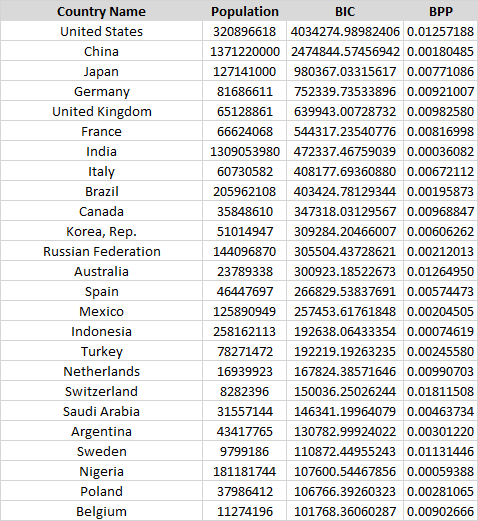You often see people in the Bitcoin community use the market capitalization of Bitcoin to compare it to the money supply of other countries. In particular, the M1 Money Supply of countries is used as a metric to measure the value of all bitcoins against. For example, Jameson Lopp recently cloned the CIA’s numbers on M1 Money Supply around the world including the value of all bitcoins, which shows Bitcoin in 32nd place. These statistics are interesting, and certainly indicative of how far Bitcoin has come. At the same time, this is a narrow way to think about Bitcoin and its growth.
There are no shortage of people that believe Bitcoin, or more generally cryptocurrencies, will replace fiat money in the future. Thinking in these terms, why limit Bitcoin to the M1 Money Supply? Won’t Bitcoin become the market, as in all transactions will occur on the Bitcoin blockchain? Putting aside the probability, or desirability, of that outcome what does the world economy look like if it is denominated in bitcoin?
A couple of assumptions. Gross Domestic Product, or GDP, is more or less the standard metric used by economists to measure the economy of one country against the economy of another country, and so, that is what I’ll use. The underlying GDP and population numbers are from 2015 courtesy of the World Bank. GDP is problematic, but it’s a decent measure of the total “value” in an economy, and remember we’re talking about a scenario where all value is transacted through bitcoin. I’m using the total number of bitcoins mined, as of yesterday, (~16.66 mil according to blockchain.info) as the number of bitcoins. Sure, I could use twenty one million as the number of bitcoins, but we haven’t hit that number yet and we don’t know what the world’s economies would look like when that number is hit.
The chart below shows the country, the population, the Bitcoin In Country, or “BIC,” and the Bitcoin Per Person, or “BPP.” I’ve listed the top twenty-five countries, and the bottom twenty-five countries according to BIC. So, how many bitcoin does each economy have?

There is nothing terribly surprising about the countries listed above, because they are the largest economies in the world. What is interesting is what their economies look like in terms of bitcoin, and in particular the number of bitcoin held by each person in that economy. But, what about the bottom twenty-five countries?

Again, if you’re familiar with the poorest countries in the world you should not be surprised by the list of countries above. What is extraordinary is that if you have 8 bitcoin you would have more bitcoin than the entire economy of Tuvalu. Does this make sense? I have no idea, but it’s shocking to think about. If you had 353 bitcoin you would have more bitcoin than each economy of the bottom 25 countries.
Conclusion
Denominating countries’ markets in bitcoin is another way to get a handle on what Bitcoin adoption means. BIC and BPP are indicators that help illustrate that point. Whether Bitcoin replaces all value transaction is a very open question, but if Bitcoin were to do that a person would not need to have a lot of bitcoin to have more bitcoin than many countries in the world.
Update: I added the full list of countries if you want to peruse them below.
